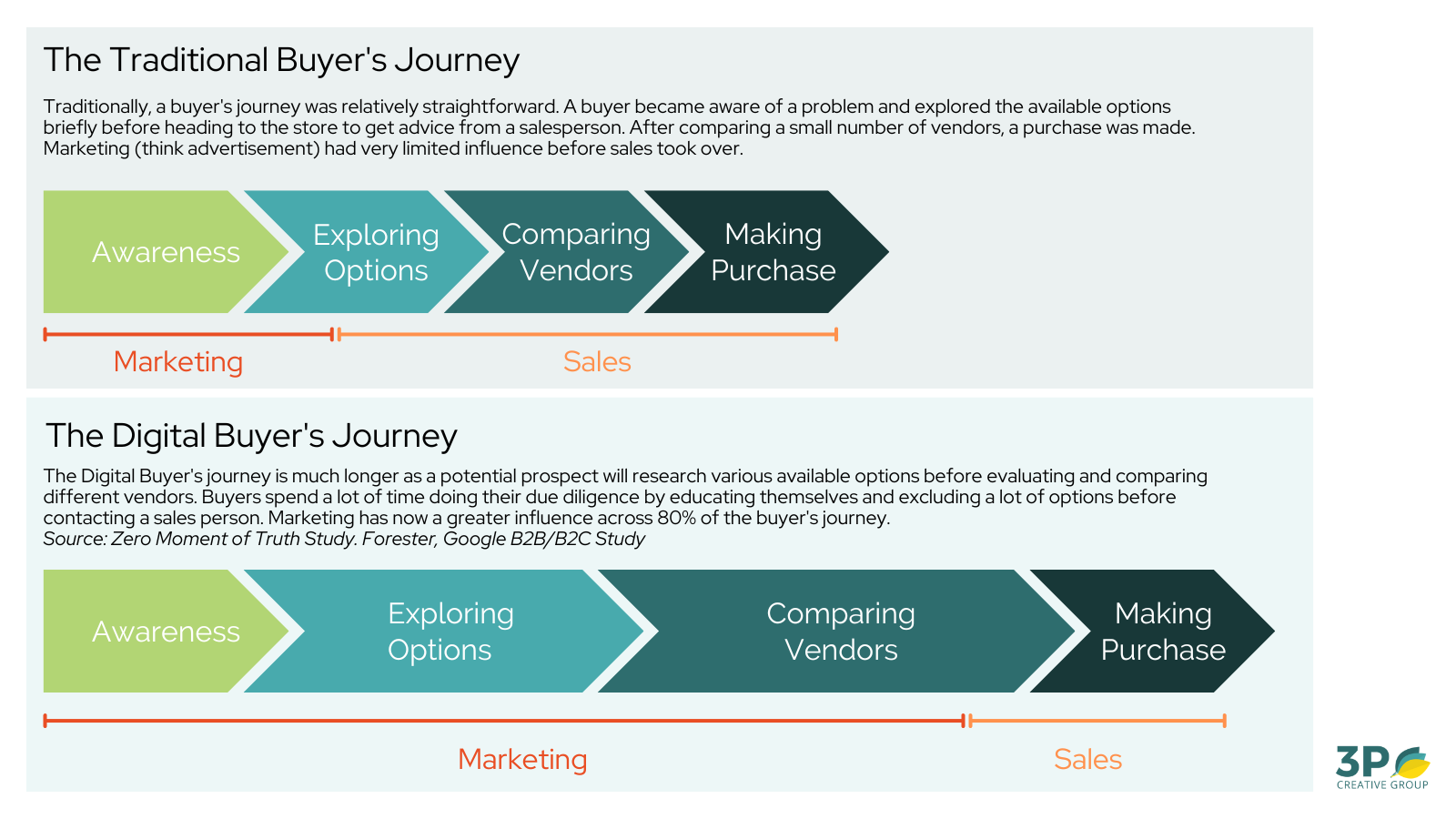Why Your Content Marketing Is Failing & What To Do About It: Pt. 3
Is your sales team complaining about the lack of qualified leads coming in through inbound marketing? And do you wish your sales team would finally use some of the content you so carefully create in their sales process?
Over the last decade, we have helped dozens of marketing and sales teams succeed with inbound marketing, and we have consistently seen one common thread whenever companies go wrong: sales and marketing just don't see eye to eye.
In this last installment of our blog mini-series "Why Your Content Marketing Is Failing (And What To Do About It)", we will examine how buying behavior has drastically changed over the last years and how this impacts the marketing and sales relationship. When you are done reading this post, you will understand how to not only align but also unite both teams to finally build a content marketing machine that will generate more and better quality leads for your sales team to follow-up on, accelerate your sales cycles, and help you close more deals.
In this post, we will closely examine the last three reasons why content marketing fails, but here are all ten reasons for your reference:
- You are talking about yourself, not your buyer's problems (Part 1)
- You are selling, not educating (Part 1)
- You don't address the most important questions: The Big Five (Part 1)
- There’s no buy-in from leadership (Part 2)
- You are outsourcing content production (Part 2)
- No one owns your content creation (Part 2)
- You do not measure what works and what doesn't (Part 2)
- You don't adapt to changing consumer behaviors
- Sales isn't involved in content production
- Sales isn't using content in the sales process
Let's get started.
You Don't Adapt To Changing Consumer Behaviors
When we founded 3P Creative Group in 2012, there were 42 million blogs, and 500,000 blog posts were published daily, according to Jeff Bullas. Ten years later, in 2022, there were 600 million blogs, and 7.5 million blog posts were published daily. While the enormous explosion in the number of blog posts published daily (and blogs in general) is a nod to the success of content marketing, it also shows us the insatiable appetite for quality content our audiences have.
However, publishing just any blog post on just any topic isn't going to drive organic traffic and qualified leads anymore! Because everyone is doing it, it isn't a competitive differentiator anymore. However, those companies who are willing to tackle the topics no one wants to address (how much it costs, what the potential problems are, etc.) will thrive.
Why It Doesn't Work
Back in the day, when the internet had just started, buyers had to go to a store and talk to a salesperson to learn more about a product they wanted to buy. This meant that buyers themselves completed 20-30% of the buyer's journey (e.g., by talking to friends and reading or watching ads) while the rest was sales assisted.
Now, a prospective customer is about 80% through their own buyer's journey by the time sales becomes aware that they exist. This means marketing has a much greater influence compared to sales and is now responsible for answering questions buyers obsess over. And if a buyer doesn't find this information within 10 seconds on a website, they move on until they find a site that provides it. (Hint: This company is usually the one who gets their contact info if not their business!)

What You Can Do About It
Companies that embrace the new buying behaviors of the Digital Buyers thrive, while those who continue as before struggle badly. For this to work, you will need to unite your marketing and sales teams behind a common goal: your customer. Unfortunately, marketing and sales often don't see eye to eye.
One of the best ways to get everyone company-wide on board is to hold a sales and marketing alignment workshop. You can hold one in-house, but it is often more effective to bring in an external digital sales and marketing coach. Not because they are better or smarter than your internal team, but because they bring an intrinsic value as an outsider looking in.
Sales Isn't Involved In Content Production
I have helped B2B technology companies do their content marketing for more than ten years, and I have written more than a thousand articles. More times than not, the marketing team builds an editorial calendar without the input of sales.
Why It Doesn't Work
Content produced without the involvement of sales inadvertently doesn't answer questions your actual buyers are asking. Blog posts, press releases, and other articles or guides tend to be very product focused (e.g., new feature release) or company news oriented (e.g., company x won an award) but they stay away from questions like "How much does it cost?" or "How do you compare to this product?" Consequently, sales finds the content useless and won't send it out to prospects and customers during the sales process.
What You Can Do About It
One of the most effective ways to ensure that your content is answering your buyers' questions (and therefore performs well) is to create a so-called "Revenue Team." A revenue team not only aligns your marketing and sales teams but also unites them. And the best thing is that it isn't complicated to set up at all! But I highly recommend doing an alignment workshop before to get everyone on the same page, so everyone understands WHY this is important.
Want to learn more about how to create a revenue team? Head over to Impact+ for a free course titled "The Revenue Team Approach To Sales Enablement Content."
Sales Isn't Using Content In The Sales Process
Finally, if your content isn't answering your buyers' questions, sales finds it unhelpful in the sales process and won't use it to move their prospects through the funnel. This artificially slows down your sales cycles and has great impact on your closing rates.
Why It Doesn't Work
If marketing influences 70-80% of the buying process (remember, the Digital Buyer wants to have maximum control and does as much of the research as they can by themselves), we must create content that is useful for each step of the buyer's journey.
And the more educated our buyers are, the faster the sales process and the higher the closing rates. In fact, studies have shown that if a prospect reads 30 pages of sales enablement content, they have an 80% closing rate! If we don't provide that content, prospects simply will look elsewhere to get the answers.
What You Can Do About It
Once you align your sales and marketing with the help of a revenue team, your content manager's or team's primary customer becomes the sales team. Their job will be, first and foremost, to create buyer-centric content that answers real customer questions. This content will be so valuable to the sales team that they will start assigning it as homework. This is a highly effective sales method called assignment selling.
Conclusion
In this mini-series, we have covered the ten most impactful reasons why your content marketing is failing: from choosing the right blog post topics, to who should be writing the content, how you should organize your content creation team, why sales should be your primary customer, and much more.
While implementing even just one or two of these suggestions will have an impact, they are part of a greater framework: They Ask, You Answer. To learn more about the sales-first methodology, read the book They Ask, You Answer by Marcus Sheridan. We also offer 1-day Digital Buyer workshops that will transform the way you approach marketing and sales today.
Related Resources:
Why Your Content Marketing Is Failing & What To Do About It Series:
Share this
You May Also Like
These Related Stories

What Is Assignment Selling & How Can Your Get Started Today?

Why Your Content Marketing Is Failing & What To Do About It: Part 1

.png?width=250&height=125&name=TrustBuilderLogoWhiteTranspBackgr(250x125%20px).png)


No Comments Yet
Let us know what you think